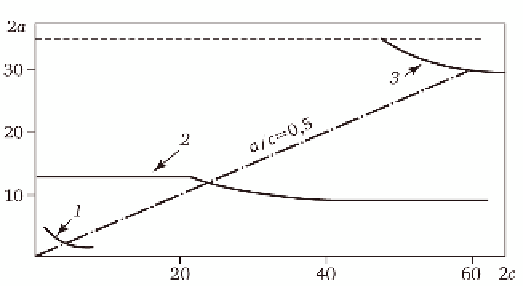Environmental Engineering Reference
In-Depth Information
Length of discontinuity
5.43
Set of discontinuities of critical size 3, size permissible in
service 2 and permissible in manufacture 1.
defectiveness on the semilogarithmic scale are shown in Fig. 5.45.
The product is inspected by non-destructive testing products using the
selected method technical means of inspection (ultrasonic, eddy current,
radiographic, or others) as well as by operators of certain qualifications.
The discovered defects are then removed.
The inspection results are represented as a histogram in the 'the
characteristic size of the defect χ - the number of identified defects of the
given size
N
det.comp.
' coordinates.
This is followed by determination of the probability of defect detection
P
pdd
, initial defectiveness
N
in
=
f
(χ) and residual defectiveness
N
res
= φ(χ)
as the difference between
N
in
and
N
det
.
These relations can be determined by various methods.
According to
one of the methods,
the NDT results are presented in the
form of analytical expressions.
The structure of the equation which can describe the NDT results,
presented in Fig. 5.44, is the following:
N
det
(χ) =
N
in
(χ)
R
dd
(χ),
where
N
det
is the number of defects detected in inspection in the unit of the
characteristic size. If as the characteristic size is represented by the minor
axis of the ellipse which schematises the defect, then the unit
N
det
- mm
-1
;
N
in
is the function of the initial (prior to NDT and repair) defect with the
same unit as the
N
det
;
P
dd
is the probability of detecting a defect of given
size χ.
The type of functions
N
in
and
P
dd
is defined on the basis of the simplest
expression, the minimum number of constants and the correspondence of the
physically defined dependence of
N
in
and
P
dd
on χ. In the first approximation
the following equations can be used:

Search WWH ::

Custom Search